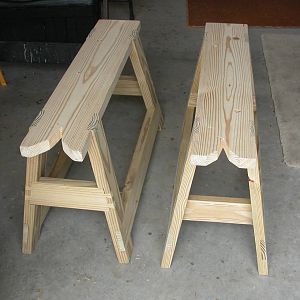I need another pair. It seems that everytime I build a pair, I've difficulty cutting the legs.


I want to splay them 15 (or so) degrees width and depth. I want to leave five inches (or so/more) at either end. I liked Sellers (How to Make Sawhorses Introduction | Paul Sellers) approach of notching the cross piece/top to secure each leg in place and I thought a two by eight top section/piece wood be useful if I have enough in the scrap pile for both horses.
 OK, so enough with the setup. I am looking for instruction on how to fabricate the four splayed legs needed for a sawhorse similar to the one shown here. I have a couple of Compound Miter saws and can set the blade to 15 degrees horizontally and vertically and cut both ends of a two-by so as to wind up with a parallelogram of whatever length necessary.
OK, so enough with the setup. I am looking for instruction on how to fabricate the four splayed legs needed for a sawhorse similar to the one shown here. I have a couple of Compound Miter saws and can set the blade to 15 degrees horizontally and vertically and cut both ends of a two-by so as to wind up with a parallelogram of whatever length necessary.
Problem is, If I cut four boards without an adjustment, I wind up with legs that only fit the left front and right rear. Now, obviously, I've been able to figure out how to cut the other two legs and (less obviously - but true) have done it many times over the years without, apparently, committing the process/procedure to memory or paper or finding a video that steps one through it.
So, If the procedure is Dick Soup to you and you've reasonable success it explaining it to old guys who should know it before getting to Joe Biden's age, I would appreciate your sharing the approach, trick, technique or magic spell one more time.
Charles
I want to splay them 15 (or so) degrees width and depth. I want to leave five inches (or so/more) at either end. I liked Sellers (How to Make Sawhorses Introduction | Paul Sellers) approach of notching the cross piece/top to secure each leg in place and I thought a two by eight top section/piece wood be useful if I have enough in the scrap pile for both horses.
Problem is, If I cut four boards without an adjustment, I wind up with legs that only fit the left front and right rear. Now, obviously, I've been able to figure out how to cut the other two legs and (less obviously - but true) have done it many times over the years without, apparently, committing the process/procedure to memory or paper or finding a video that steps one through it.
So, If the procedure is Dick Soup to you and you've reasonable success it explaining it to old guys who should know it before getting to Joe Biden's age, I would appreciate your sharing the approach, trick, technique or magic spell one more time.
Charles

